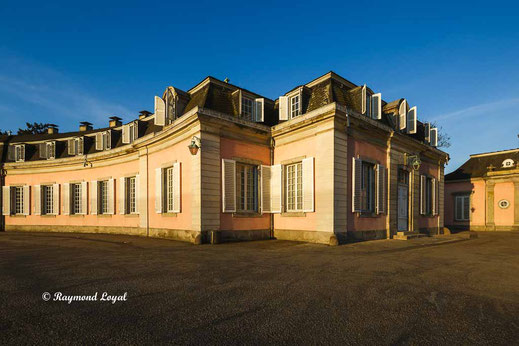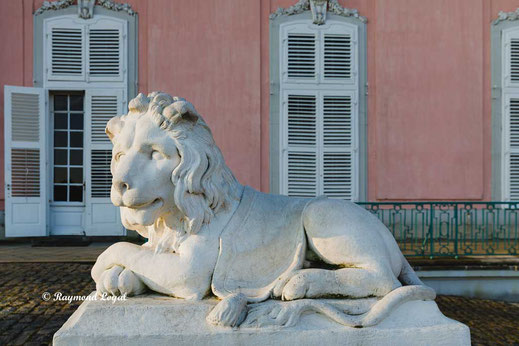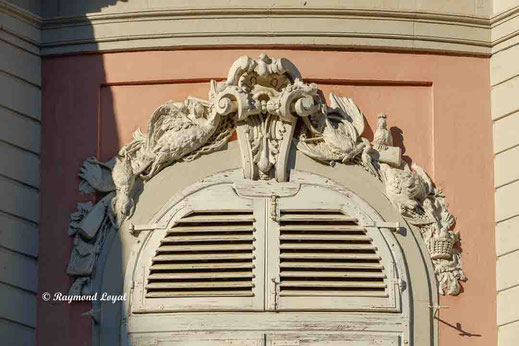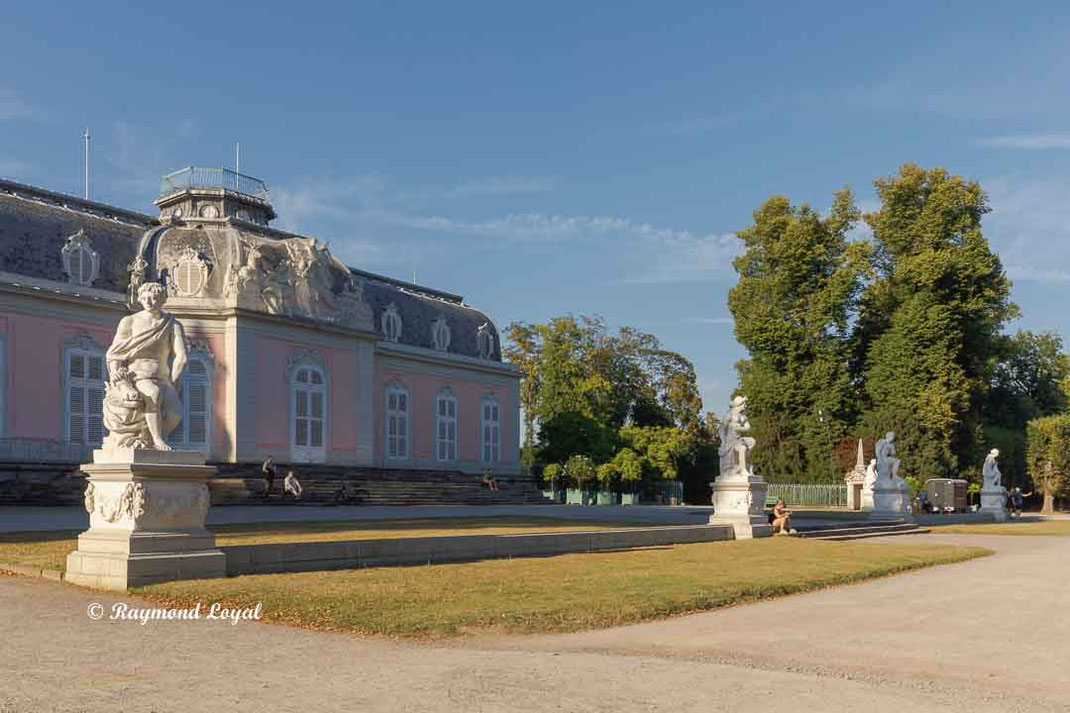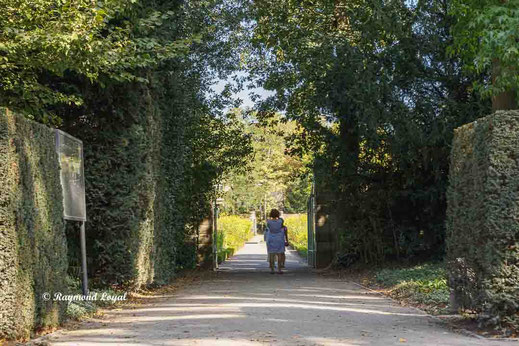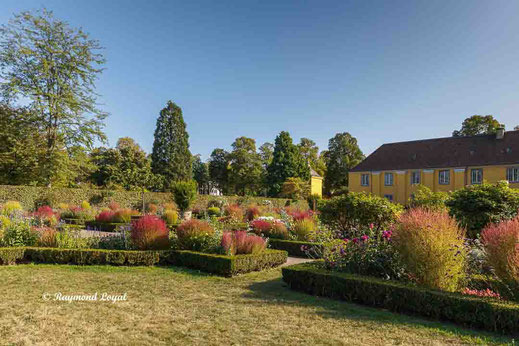Benrath Palace
Touring Germany - A picture story and virtual walkabout on Benrath Palace
Benrath Palace is a hidden treasure situated in the middle of a dense urban district of the City of Duesseldorf. The palace is part of a large landscape garden, including a number of large ponds, and is a work of the late baroque. One can say that the entire complex of the palace, the outbildings, gardens and ponds are a phantastic all-encompassing work of art well worth visiting more than once.
The palace is a true Rokoko building complex consisting of the main building, the Corps de Logis, and two separate wings. Nowadays the palace is surrounded on three sides by urban housings. A large park with water basins and fountains is part of the complex as well as a so-called French garden and a small English landscape garden, both adjacent to the Corps de Logis.
Gardens and park are open to the public 24/7 and are an important local recreational area for Duesseldorf and the people living nearby.
Navigation - Content
- Benrath Palace
- The Corps de Logis
- The Gable at the North Facade
- The Puti at Benrath Palace
- The South Facade
- Gable Group "Diana's Hunt" at the South Facade
- The Sculptures at the South Terrace
- The English Garden
- The French Garden
- The Flower Garden in the Park
- The Kitchen Garden of Benrath Palace
- The Terrace Garden
- Princes' House or Orangery
- The Mirror Pond
- The Hunting Star
- What is in for the visitor of Benrath Palace and Park?

Benrath Palace - A bit of history
Benrath Palace is situated in the same-named borough Benrath of Dussseldorf City, with Dusseldorf being the capital of the German state of Northrhine-Westfalia. On four sides, in the west, the north and the east and the south palace and gardens verge on the urban housings of Dusseldorf. Basically, palace and gardens are just across the street for many residents in the borough of Benrath. In the west, the gardens are only separated from the banks of the river Rhine by a road.
What is it all about Benrath Palace. The palace was not planned as a residence, from the outset the plan was to build a Maison de plaisance. Prince-Elect Karl Theodor von der Pfalz was the principal for this project. The palace complex consists of the main building or Corps de Logis and the two separate wings which have no connection to the main building. In addition to that there an orangery, the French garden and the English landscape garden, the pond and canal system.
The idea behind the new Maison de plaisance was to spend the summer time in the Rhineland. First plans were made in 1755. The prince-elect ordered his personal architect, no one less than a certain Nicolas de Pigage, to plan and supervise the construction of the new Benrath Palace. It is interesting to know that Nicolas de Pigage learned his craft at the Sorbonne in Paris and was quite an established expert in architecture at his time. He also worked on the Mannheim Residence and the Schwetzingen palace gardens.
In order to built Benrath Palace it became necessary to take the water castle that previously belonged to the counts von Berg, who had converted the former castle into a Renaissance-Style water castle. The parts of the Renaissance castle still standing and in use are a side wing housing the orangery and a chapel. The orangery is now home to the Dusseldorf public library.
Construction work on the palace began in 1755 and lasted for the best part of 16 years, until in 1771, finally, the buildings and the interior finish was completed.
Benrath Palace is thoroughly a Rokoko building. As is the case with all palaces build during the late baroque period, the use putti in and around the Corps de Logis is something that catches the eye.
Benrath Palace - The Corps de Logis
The term "Corps de Logis" is attributed to the main building and also describes the building where the living quarters and the dormitories are situated. The Corps de Logis is the very building where the landed gentry actually live when they happen to be about. This building is always at the centre of the entire palace complex, meaning, all wings, pavilions and corner towers, servants wings, chapels, are draped about the Corps de Logis as the epi-centre of it all.
At Benrath Palace, the Corps de Logis is a separate building, the west wing and the east wing are not connected with the main building. That set-up makes the Corps de Logis the architectural highlight of this composition.
The Corps de Logis was planned as the living quarters for the prince-elect and his wife. The east wing contains salons and bed chamber for the Electress Palatine and the west wing contains salons and bed chamber dedicated to the Prince-Elect. The windows of both salons face south and allow for a beautiful view of the mirroring pond in the parc.
Benrath Palace - The Gable at the North Facade
It is hard to overlook how elaborately the northern gable was designed. On the entablature of the medium risalit sits a pointed gable in which the Prince's Elect coat of arms, fitted with crown and wings, is incorporated. The coat of arms is flanked on the left side by a lying lion and on the right hand side by a sitting lion. In heraldy the lion stands for courage and also symbolises the high rank of the noble.
Both lions are flanked each by a group of four winged puti, that attend to the lions.
A clock group sits on top of the gable. We see a winged puto lying on top of the clock glancing into the distance, whereas another puto lies left hand beneath the clock looking up to the clock. The creator of the clock group was Peter Anton Verschaffelt.
One group of puti each is placed to the left and to the right of the gable, each time flanking a vase sculpture. The puto next to the gable stands straight and the opposite puto sits. The standing puto of the left side carries a spade symbolising the craft of a gardener whereas the puti ensemble on the left-hand side seems to be happy with holding a feston.
The Puti of Benrath Palace
As is the standard in many baroque palaces in North Rhine-Westphalia and in Germany, Benrath Palace has its own programme of puti. Puti populate the facades of the corps de logis and are also numerous inside the house.
Though, what puti actually stand for? A simple explanation is that puti are the children in art. Matter-of-factly they are always depicted as small children. Puti never grow old, always remain a child and are always busy with doing something. They go about their activities either in earnest or do something with joy. It is the lust for life that makes puti radiate with bliss and also shows the sensation of a life without worry and suffering. The puto is the child that does not know about lamentation, suffering, worry and hopelessness. Instead the puto is carefree does not care at all about the outside world. No schemes and cabals, just love and playfulness are put on display and are the motto of a life.
If and when we were to ask ourself whether or not that could be us what would be our answer? Everyone can only answer that queston for oneself. In connection with the creation of parks and gardens this figure of art is given the task of distracting from the worries of daily life.
The facade of Benrath Palace is the first place where we meet with the little knobly fellows, which are busying themselves with holding something even if it only a spade or a feston. Though, that is something they do with ease of being, without asking themselves the question of being or the reason for their existence. They can do without any philosophic reflection and are enough to themselves. Happy little fellows one might be tempted to conclude. Although the puti at the gables are exposed to the weather and are also gonen through the centuries they have not lost their carefree lust for life.
The South Facace
The south facade of the corps de logis looks to the south and onto the mirror pond in the park. The domed hall of the house, which is behind the protruding middle part of the facade and the adjacent garden rooms to both sides of the hall occupy the south front of the house. The central door is aligned to the north-south-axis cutting exactly through the centre of the house and opens the domed hall towards terrace and mirror pond; whereas the side doors of the hall reveal the view into the two main alleys leading into the park and to the gardens. When looking to the west the observer directly looks down the main alley (looking from the left door in the image) leading to the middle of the woods (grand park), while looking to the east leads the view into the alley that leads to the kitchen garden and to the terrace garden (the right door in the image).
The ornaments of the door arches are all individually designed and show hunting motives. Especially the three ornaments over the arched doors of the domed hall are the most magnificently designed as can be seen in below images.
Gable Group "Diana's Hunt" at the South Facade
The south facade is a complete piece of art abundant with ornaments and attention to detail, as we already have seen in the articles above. In all the south facade is a beautiful view. However there is one piece of art taking not just the prominent place at the gable but requires the observer to pause and study all the details of the gable group at the south facade. We are looking at an artwork called "Diana's Hunt". The gable is covered by a net to preserve the artwork. Still we can fathom the details.
The gable group shows "Diana's Hunt", with Diana being the Roman goddes of the hunt. One of the central elements of the gable group is typically baroque-style shell on which the sculpture of Diana is sitting. The entire gable group is more than fitting to the ornamentation and the art of the south facade which is all about hunting. A ten point red deer lies on the left of gable while being attacked by three hunting dogs. On the right hand side again, there are hunting dogs, this time two which on lying and one being on the jump. The puto sitting behind the dogs just holds a string.
Diana herself sits on the shell on which a net is spread falling down on both sides of the shell. The sitting sculpture leans on a cart and holds a bow in her left hand. The arrows to be used on the bow are in a quiver being overseen by a puto sitting left to the goddes sculpture. A feston formed by acanthus leaves is fixed at a rocaille at the right and runs across to the left side rocaille which is covered by the net, thereby forming the bottom of the artwork.
The artwork was created by Peter Anton Verschaffelt.

The Sculptures at the South Terrace
All ways leading into the park start at the south terrace, moreover, the south terrace is the terminus of the line of sight represented by the mirror pond that is symmetrically in line with the middle of terrace and house cutting straight through the salon. A wide staircase leads down to the terrace. At the end of the terrace we find a group of six sculptures lined up between the two sentry boxes. The sculptures form the outer limit of the terrace glancing directly towards the pond. The centre foure sculptures stand parallel to the house.
When looking at the sculptures closely we will find out that the sculpture programme of Benrath Palace is based on Greek and Roman mythology, which was standard at baroque palaces and gardens in the 18th century. Looking towards the house we can see all sculptures at a glance. From left to right the sculptures are: Atalante, Meleager, Flora, Pan, Pomona and Bacchus. The positions of Atalante and Bacchus are slightly backwards and close to the sentry boxes.
Whom or what do the sculptures stand for?
Atalante is based in Greek mythology where she is a virgin hunting maid. The story about Atalante is that her father wanted a son and was disppointed to be presented with a girl, prompting him to expose the newborn to the wild mountains, where she was fed with the milk of a bear and over the years developed into a strong and audacious hunter. She was not interested in men and opposed marriage. Meleager was the son of Oineus and Althaia. It happened that Oineus failed to honour the Greek goddess of hunting properly which induced her to sent a boar to terrorise the people and ransack the countryside. In order to re-establish good relatioons with Artemis the boar had to be killed and offered to her as a sacrifice. Easier said than done and a team of strong hunters was put together, thereby also accepting Atalante as an equal member of the squad. Atalante brought down the boar and stepped back allowing Meleager to kill the beast, leading Meleager in turn to bestow the price on her, which in turn generated plenty of trouble in Meleager's familiy. In the end Meleager becomes victim of his own destiny and dies.
Flora is the goddess of flowers and blooms in roman mythology whereas Pan is the god of the shepherds and based in Greek mythology. Pan is also known as a lover of music and is also said to have invented the panpipes with which he is always depicted.
The next pair of sculptures is based in Roman mythology. Pomona is the goddess of the crops and the fruit blessing, fruiting trees and of the gardens. Though, in Roman mythology Pomona is a more second rated goddes but is mentioned in Ovid's Metamorphoses where she plays a role as spouse of the god Verumnus. Bacchus on the other hand is originally a Greek god where he was the god of wine, enjoyment and theater. The Romans incorporated the figur of Bacchus into their own mythology where Bacchus was the god of wine, ecstasy and frenzy. Bacchus is always depicted holding a vine stock and slightly fluffy.
Benrath Palace - The English Garden
The English landscape garten at Benrath Palace belonged to the private gardens of Prince-Elect Karl Theodor. However, the current shape of the garden is the result of restructuring work done towards the end of the 19th century. At that time the bridge in the garden was added and the trees were planted.
Benrath Palace - The French Garden
The French garden at Benrath Palace also belonged to the private gardens of the Prince-Elect but was used by his wife Auguste. Even nowadays, one can see the stringent symmetry of the original garden. The main piece of the French garden is a lawn parterre, bordered by flowers. To the east the garden is extended by a set of six pools with fountains and cascades.
The Flower Garden in the Park of Benrath Palace
One way of accessing the flower garden is by walking through the English landscape garden. Another way of entering into the garden is by walking through the western guardhouse, provided the building is open. The flower garden is also Schiller's garden.
The flower garden provides a playground for children. That apart, the garden is full of flowerbeds, bushes, shrubs and lemon trees. Large lawns are open to the public. Please find some pics of the flower garden below.
The Kitchen Garden of Benrath Palace
Actually, the name kitchen garden says it all. You will find everything necessary to supply a kitchen on a daily basis with vegetables and fruit und you will find all that in the kitchen garden in abundance.
Matter-of-factly, in medieval times kitchen or herb gardens were a substantial part in the supply of castles. The lord of the castle, his man and their families were dependent on a well-stuffed garden. During Renaissance kitchen and herb gardens were part of the garden programme and later in baroque the kitchen garden still was essential for a working palace kitchen, even though the kitchen garden was no longer part of the official garden show.
The Benrath Palace kitchen garden is within a high brickwall with two gates. One opens to the palace the other, lying opposite, connects to "Urdenbacher Allee". Visitors coming directly from the palace just turn left after about 200 metres and then there is the garden. Within the walls one way goes round alongside the wall and there are also ways leading through the vegetable beds. There are park benches put up alongside the walls for visitors to rest and fathom the smells of the garden.
What do we find in the Kitchen Garden of Benrath Palace?
In the vegetable beds we find peas, beans, carrots, different kind of salads, several kinds of cabbages, there are pie plants, corn or maize, spices such as parsley, chives, tarragon, sage and much more. We also find berries, fruit trees, strawberries, potatoes, sprouts and asparagus. The garden produces enough to supply a large palace with all that is needed all over the year.
The Parterre Garden of Benrath Palace
A typical element of baroque gardens is the so-called parterre garden. The name originates from the fact that one had to descend from the palace in order to reach the garden, or - in other words - from the viewpoint of the palace, the parterre garden mostly bordered a terrace of the palace, though, at a lower terrain level, so one had to descend to the garden. As seen from the palace terrace the garden lay at the observers feet. So much to the basics of terrace gardens.
At Benrath Palace the terrace garden lays at a lower level than the corps de logis but one has to walk a distance of about 250 metres. The garden is surrounded by a neatly cut hedge of shrubs and towards the south opens to the Orangery or Princes' House.
The closeness to the orangery is obvious for there are dozens of pot planted orange trees in frontt of the building and all over the garden. In the garden we find a lot of different flowers and plants such as asters, roses, marguerites (or dog daisies, French daisies, common daisy), dahlia, zinnias and much more. All things considered one can conclude that the terrace garden is well made and provides some quality time to the visitor. The garden is well worth visiting at least from spring to autumn (fall). Top reccommendation.
The Princes' House - Orangery (Old Palace)
The princes's house or orangery is a wing-shaped building, which used to be part of the old palace. The facade facing the terrace garden has four pilasters on each corner of the building and painted in the typical baroque-style yellow.
Benrath Palace - The Mirror Pond
The mirror ponds is set up in a north-south direction and almost directly verges on the alley crossing in front of the south facade of the Corps de Logis. During spring and summer time a fountain is in operation. From the far end of the pond, the visitor can see the palace reflecting in the water of the pond. The pond is part of the southern visual axis of the palace.
The Baroque Hunting Star in the Park of Benrath Palace
The grand parc or woods are a part of the baroque garden and park. On the one hand the woods were used for timber production and for hunting and on the other hand the woods served the recreation of the palace residents. The baroque avenue star or hunting star is the place where the main avenue leading into the woods meet. From this place there are lines of sights possible in all directions. The hunting star at the park of Benrath Palace is such a place.
The Hunting Star measures 60 metres across and connects eight avenues at the very centre of the woods. The centre of the Hunting Star is occupied by a lawn. A central west-east axis runs through the middle of the place and allows a nearly unhindered view to the mirror pond and the "Viereckweiher" (quadrangle pond).
What is in for the visitor of Benrath Park and Palace?
Apart from the museal aspects Benrath Palace has a lot to offer to the visitor.
Benrath Parks and Palace are the top recreational area in the south of Duesseldorf. Local people don't have to travel far in order to arrive at the park. The parks are open 24/7 and are widely used by joggers starting in the early hours of the morning and through the day into the evening and that every day.
Benrath Parks are a lovely place for walks. The vastness of the place with a system of gardens, woods, ways, avenues, hunting star and the baroque lines of sight offer a plethora of options to any visitor.
On top of that Benrath Palace is the ideal background for photo shootings and is the top address for bridal coupels. Besides getting married at Benrath Palace is possible.
Dog owners love the park because of the size of the complex.









